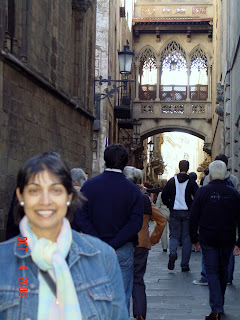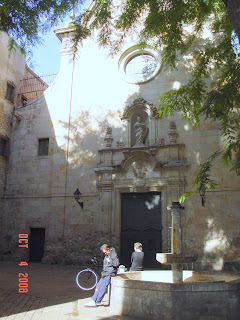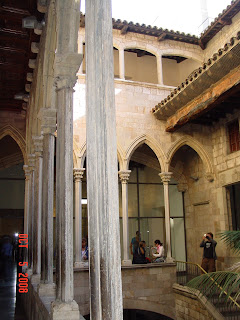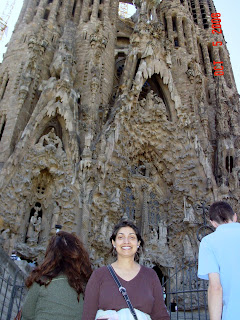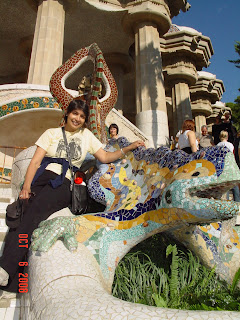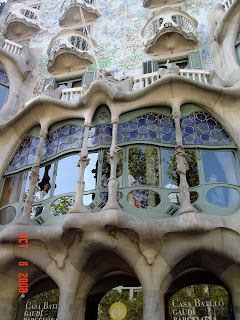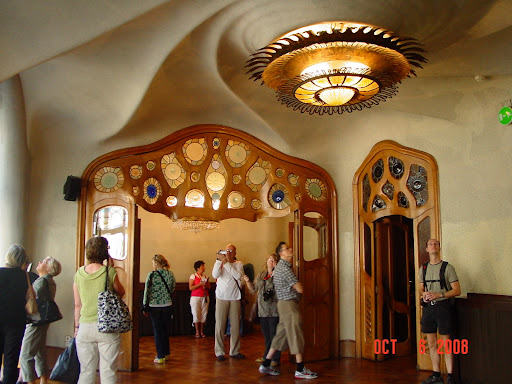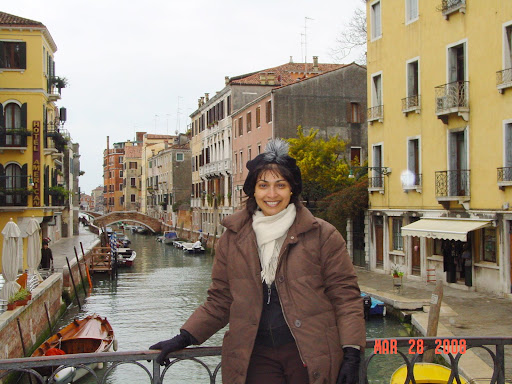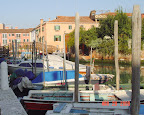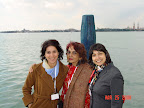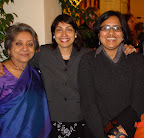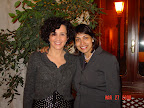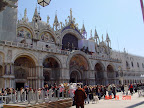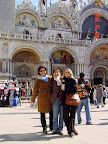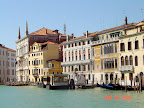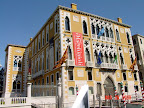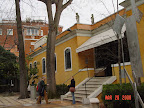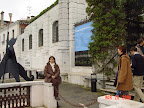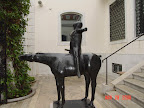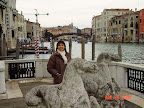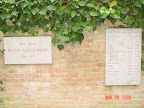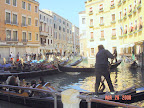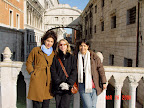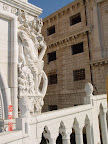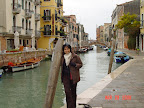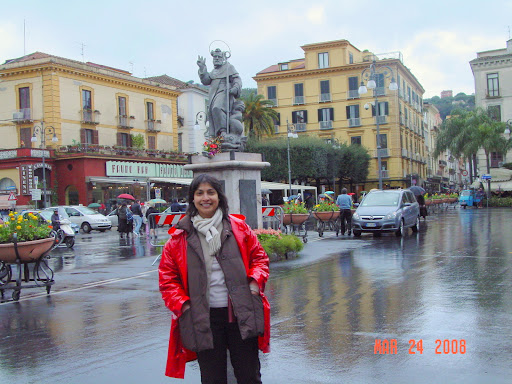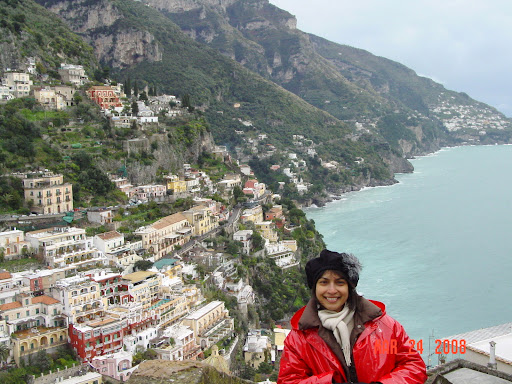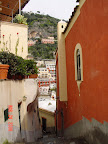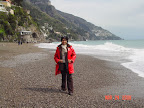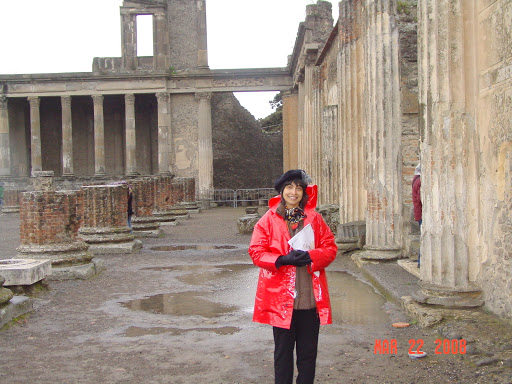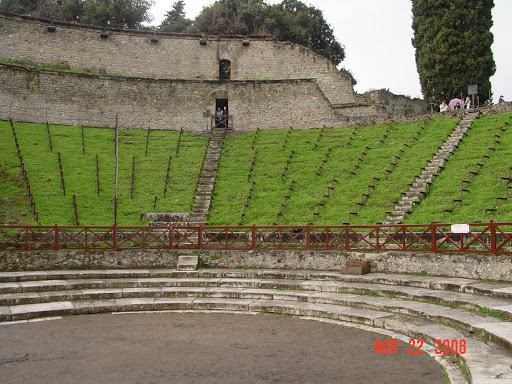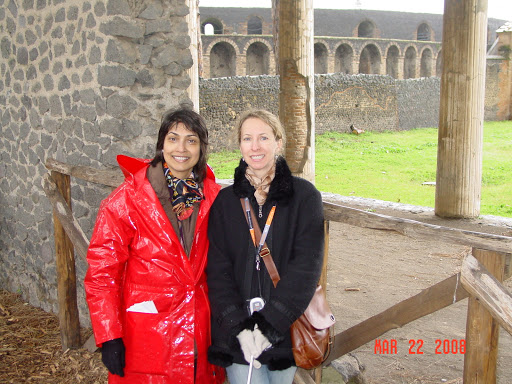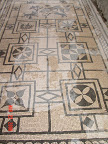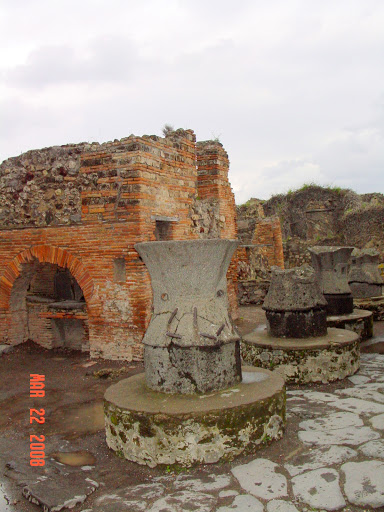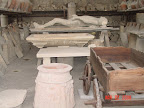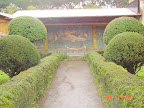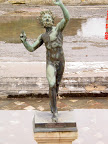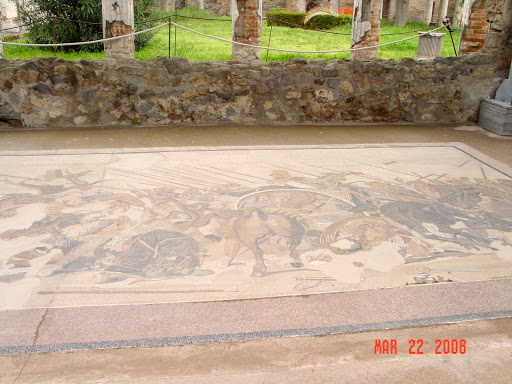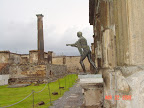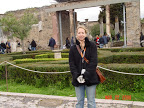Posing by a real Oscar at the Kontiki Museum in Bygdoy Peninsula
I only knew Norway as the Land of the Midnight Sun, open face sandwiches, and those gorgeous Scandinavian blondes… As for the rest of it, I was blank. Which turned out to be a good thing because Norway was a revelation.
Just before we landed at Torp airport outside Oslo, after we had cleared the thick layer of clouds that had obscured the scene outside the window all across the North Sea, the sights of the fjords had me spell bound. For though there was no sun, there was enough light to be able to discern the outlines of scattered islands that lay under a thick frosting of ice. This famed coast line viewed from the air but best seen on summer boat cruises, was my first glimpse of the country, Norway—a country that revealed itself to me in new and exciting ways from day to day and left me enchanted.
Country Landscape:
It was plainly obvious that southern Norway had gone through a major recent snowstorm. Tall mounds of snow almost blinded me in their dazzling white garb. However, unlike London, it was also plain that the authorities were fully equipped to handle it for snow ploughs were everywhere and the sanding and salting of motorways leading out of the airport was superbly done.
Once we arrived at the highway that led to Oslo, the landscape was so enchanting that each little vignette could make a Christmas card. Within seconds, I was reminded sharply of my own home in New England for there were so many similarities. For one thing, because both Norway and New England have an abundance of trees, all structures are made of wood (unlike the brick and stone that I so love in the United Kingdom). The siding of homes were exactly the same was those in parts of New England in which the Pilgrims settled—indeed similar to my own Holly Berry House in Southport, Connecticut. The three preferred colored of all dwellings are white, ochre and maroon, or as some would more fashionably say, burgundy. These little cottages were draped in white shrouds, their roofs thickly covered with snow. Most trees stood bare of foliage, their branches still wearing traces of freshly fallen snow while conifers stood in clumps draping the hillsides. Occasionally, we past vast spreads of snow white land masses which we soon realized were snow-covered lakes as the boat slips at the edges gave them away. I was taken back sharply to my coastal Connecticut winters as I watched the beauty of the Norwegian countryside slip by the window.
Day One in Oslo–Breakfast at the Youth Hostel:
Because I had managed to get some reading done from my Norway DK Eye Eyewitness Guide en route to Stanstead airport, I decided that I would spend my first day in the City Center getting oriented. It seemed that the city was rather small and could easily be explored on foot.
Attempting to avoid what I imagined would be the early-morning rush for the bathrooms down the hall, I decided to shower in the evening. Dressing warmly, I went downstairs to the dining room for breakfast (included in the price of 22 Euros per night) and thought I was in a hotel. Truly, after the breakfasts I have consumed in other European youth hostels, this one appeared princely. There was a variety of cereals with milk or yogurt, a buffet bar with rolls, various types of sliced bread and the famous Scandinavian crisp bread and all sorts of jams and marmalades as well as a rather chunky and very delicious apple sauce. In the deli bar, there was cheese (Jarlsberg, of course, Norway’s gift to the world) ham, salami, liverwurst, coleslaw, fresh sliced tomatoes and cucumbers and a variety of fish dishes—in mustard sauce, tomato sauce and pickled with onions. There was also a variety of juices, tea and coffee—like I said, fit for a king. There was even a traditional brown cheese called geitost, served in a round block with a cheese knife. This is eaten at breakfast, very thinly sliced, and when I tasted some, I found this goat’s cheese sweet, sharply flavored and very delicious, especially when placed on the crisp bread and eaten with the tomatoes. I found myself crafting very creative open sandwiches each day for breakfast! Well, when in Oslo…..
Exploring Downtown Oslo:
Well fortified to face my day, I left to explore the city. Katya from Brazil joined me on the downhill trek to the tram stop which I boarded ten minutes later. It promised to be a beautiful day for the sun was just beginning to gild the snow draped hills and being warmly clad myself, I wasn’t in the least uncomfortable. One great thing about New England winters is that they teach you now to dress in layers and feel snug.
Oslo’s National Gallery:
Fifteen minutes later, I was at Karl Johans Gate which is the main artery that runs through the City Center. I headed first off to the National Gallery mainly to see The Scream by Edvard Munch, Norway’s best-known artist. Not only has this painting being stolen from this museum twice, but it has been, miraculously, recovered twice as well! One of the things that visiting the world’s museums has taught me is that no pictures in the world can prepare the viewer for the actual size of famous paintings and, time after time, I have been surprised at how small the real thing is when all I have seen were pictures. The Scream is small indeed but rather riveting. In the Munch Gallery, there was also his other famous work, Madonna—these two were held behind plexiglass shields.
A few rooms away, there was a special exhibition on his very personal work The Sick Child, based on his memories of his sister who lay dying of tuberculosis. There were various versions of this subject, painted over twenty years, the work getting more and more Expressionistic as he progressed. I was so fortunate to be able to see about eight version of it all gathered together in one room, as well as the definitive one which was the center piece of the exhibition.
In addition to works by Munch, there were some wonderful Norwegian artists represented such as J.C. Dahl, Tilemund and Dude and some other canvases by Old Masters—After the Bath by Renoir was particularly lovely as was St. Peter by El Greco. Tilemund and Dude’s Norwegian Bridal Party on display in this museum has achieved iconic stature in the country as it comprises all the elements that best portray Norway—mountains, lakes and traditional rural people dressed in their colorful bunads. Best part of all was that this museum was free to the public and though there was almost no one when I first entered, a few tour groups did arrive later in the day.
The National History Museum:
Right next door to the National Gallery is the National History Museum—also free of charge. I entered it to find myself lost for the next hour as I took in some marvelous medieval art. There was the front portal of a traditional Stave Church—richly carved and in a fantastic state of preservation though dating to the 1100s. I did not appreciate it right away but, a few days later, after I saw and entered a real stave church on Bygdoy, I realized where exactly at the church door it would fit and I was then so taken by this piece.
A special exhibition on the Vikings taught me a great deal about these people who originated in Scandinavia. All I had known about the Vikings was that they were violent marauders who destroyed abbeys in Ireland. So I was pleasantly surprised to see the artistic streak they also possessed as evidenced in the silver-studded sword handles and the vast amount of metal jewelry (mainly brooches to hold their flowing garments in place) that they produced. In the Sami section, I saw a great deal of material on the ethnic people who thrive in the northernmost reaches of Norway and, as my school geography lessons had taught me, live in igloos, wear reindeer fur and travel on dog sleds. It was thoroughly enjoyable. Everywhere I went, I saw the museums filled with school groups on field trips, their teachers actually teaching them lessons in the galleries.
Karl Johans Gate:
Then I was out on the sunshine-washed streets of Oslo walking towards the Royal Place called Slottet that sits on a hill overlooking the city’s main thoroughfare called Karl Johans Gate. The word ‘gate’ in Norwegian does not mean ‘gate’; it means ‘road’ and this one named after one of Norway’s most illustrious kings, Karl Johans, is its busiest. Groups of tourists were out by this time, slip sliding on the ice and throwing snowballs at each other. There were no guided tours of the interior in the winter but I did enjoy the exterior environs of the palace that are set in sprawling lawns open to the public—all thickly covered with crisp and spotlessly white blankets. The current monarchs were resident in the palace as was evident by the flag which flew from the flag mast.
I walked downhill towards the National Theater and paused to take pictures of the sculpture of Henrik Ibsen of whom Norway is so proud. The National Theater was actually putting on a production of his most famous play A Doll’s House together with Shakespeare’s A Midsummer Night’s Dream, and Dostoyevsky’s The Brothers Kazamarov. A few steps away, the grand Neo-Classical building of Oslo University lay ahead of me in its own square. The Aula is its most interesting feature—a room that is covered with murals by Munch–but since it was under renovation, it was closed to the public.
The Wonders of Radhuset:
Using my map, I found my way, a few blocks away, to Radhuset, the City Hall, and scene, each year, of the distribution of the Nobel Peace Prize. This extremely modern building built by Arnstein Arneberg and Magnus Poulsson, who won a competition to design it, dominates the cityscape by its unusual shape and conception. The exterior is only the beginning, however, as the inside of the building, covered with murals, sculptures in bas relief and almost floor-to-ceiling size paintings is breathtaking. The public can move freely from room to room including the Chamber where the Council meet to debate state affairs. Norway’s leading artists have painted each one with murals. Filled with traditional carved furniture, they are truly a delight to explore while the brilliance of the architecture is never very far from one’s mind.
Right outside the Radhusett is the Nobel Peace Center (which is open to visitors) but for lack of time, I decided to forego visiting it and proceeded towards Akker Brygge where I found a cozy corner in a McDonald’s overlooking Oslofjordden, for Oslo is indeed situated at the head of a fjord and the sun gleaming on the ice-filled waters was a lovely sight indeed. I spent almost an hour there watching the ferries come in and take off for the many islands that dot the fjord and admiring the sight of the turrets of nearby Akershus Slott (also closed in the winter), a castle and fortress that also contains the remains of some of Norway’s most prominent monarchs.
Christiana Torv and Oslo Domkirk:
Using my Guide Book, I then walked towards Christiana Torv (or Christiana Square) which is one of the oldest and best preserved of Oslo’s medieval squares. Indeed, I was so taken by the beautiful old structures that comprise the square that I braved traffic moving in slow circles around the ice and took many pictures.
Then, since most European capitals have at least one spectacular cathedral, I went in the direction of the Domkirk, only to find it completely shrouded in ugly scaffolding and completely closed.
How delighted I was to find the hill leading to the hostel covered with tiny tots sledding and tobogganing on the slopes in the noisy company of their parents. Indeed, the Norwegians really do know how to enjoy the winter and make the most of its pleasures. As the sun was about to disappear behind the hills that surround the city, I decided to sit outside myself and watch it wave its magic wand upon the ice making the countryside seem as if asleep under a diamond encrusted comforter. It was pure magic and I was glad that I had not missed the beauty of winter completely this year but had caught some of its glory in Scandinavia.
Day Two—Exploring Bygdoy:
The Viking Ships Museum:
I decided to devote Day Two to Bygdoy (Like Big Boy, except this is Big Doy!), a peninsular that juts into the fjord. Once an island, it was reclaimed by Karl Johans and now had a motorway that connects the island to the mainland. Claimed as prime real estate, it has a number of embassies and consulates located here as well as beautiful residential mansions and homes that were magically transformed into million-dollar beauties under the cover of winter. I loved the drive on Bus Number 30 that got me to Bygdoy and having purchased an Oslo Pass for 24 hours (220 kroner), I was able to visit all the museums on the peninsular free of charge as well as use all forms of transportation for free.
My first port of call was the Viking Ships Museum which is set in a fabulously designed building (by Arnestein Arneberg in 1914) in the shape of a cross—each arm containing one of the ships themselves. These ships were found in burial mounds (similar to the concept behind the Sutton Hoo Buried Viking ship and its contents in the British Museum) in southern Norway. The three 1000 year old Viking ships, the Oseberg, the Gokstad and the Tune ship (this one in the least well-preserved state) were excavated in the early years of the 20th century, then restored beautifully and exhibited in this museum where they stand as silent sentinels of Norway’s history, telling, nevertheless, many intriguing stories of belief in the afterlife. We saw a burial chamber as would have been on every ship together with a vast number of metal artifacts that were buried with the dead. The gold, silver and previous jewelry that would have also been buried with the dead Viking chieftains were plundered many years ago, but the articles left behind speak eloquently of a long lost civilization that once lorded it over the waters of Europe. The ships and the hoard left behind had me spellbound.
The Nordic Folk Museum:
A short stroll away along ice encrusted streets is the Nordic Folk Museum, a vast open air museum that documents the lives of Norwegians through the centuries. While it must seem like Disneyland in the summer when mobbed by tourists, it was empty but for a few school kids who had come with their teachers on field trips. Despite the cold, they enjoyed themselves fully in the open air running around in their winter gear and playing tag.
My tour book had informed me that there were three highlights I should not miss in this vast space and I headed first for Gamlebyen or Old Town, a cluster of homes, shops, post office, etc. dating from the last century and transported to this space in a bid to preserve them. These Tudor-like structures with their stucco walls and exposed beams had a quiet beauty about them. Inside, I could peak into the rooms and see the fitments that proclaimed the kind of rural lives led by Norway’s ordinary people back in the day.
Following the path through the museum, I arrived at a grand building that was open. I pushed the heavy door and found myself in an apartment building. Each floor was recreated to produce an idea of what life would have been like in Oslo over the past century. There was, for instance, an apartment decorated to look like the interior of Torvald and Nora Helmer’s home in Ibsen’s A Doll’s House. This was superbly done and I felt as I was on the film set with Jane Harris and Jason Robards in the film version that I have seen. And wasn’t Torvald played by Christopher Plummer? On another floor, there was a replica of the apartment once owned in the 1960s by Norway’s then Prime Minister. The Beatles played on the radiogram, Beatles and Rolling Stones posters filled the walls of the teenage son’s room and the gadgetry in the kitchen spoke of cozy family dinners in the winter. Loving interior decoration and design as much as I do, it was a treat to wander through the silent home and try to place myself in those epochs.
Then, I was out on the street again making my way towards Setesdaltunet, a whole street containing old wooden homes built on stilts that were transported from Setesdal in Northern Norway and brought there. The snow was melting in the bright sunshine and fell in great big drops on the grounds or formed mini-stalactites around the eaves of these charming wooden structures—many of which I entered and found to be dark and sparse.
The last highlight of this museum, according to my book, is the 11th century Gol Stave Church and to get there, I had to climb a steep winding hill to gaze upon a small wooden church that was very reminiscent of the many pagodas I saw in Thailand in the ancient wats that dot the Northern highlands. The layers of the church’s exterior were densely covered with snow (at least six inches had fallen) but it was the inside that was amazing. The rear wall was covered with a faint painting of the Last Supper and in front of it was a very rustic altar—just a table basically with two candle stands. It was in this church that I saw the carved portal at the door which took me back to the magnificent specimen I had seen in the History Museum and I realized where in such a church, this sort of structure would fit. It was mind blowing and the impressions these discoveries made on me were heightened by the utter silence of the landscape that allowed me to contemplate my surroundings and seemed to spiritualize my discoveries.
The Kon-Tiki, Fram and Maritime Museums:
It was time then to board the bus (the Oslo Pass includes free transport on all modes of transport) and make my way to the tip of the peninsula to get to the Kon-Tiki Museum. I had done bit of reading and knew that the Kon-Tiki is associated with Thor Heyerdahl, one of Norway’s best known oceanographers. Indeed, Nordic sea-faring history which began with the Vikings who were aggressive sailors, explorers and adventurers, carried forward well into contemporary times in the many explorations and experiments undertaken by Heyerdahl throughout his life.
The Kon-Tiki Museum documents the two main voyages he undertook—one from Peru to the Easter Islands with a crew of six in a balsam raft he called the Kon-Tiki and another called the Ra II, a papyrus boat (as existed in ancient Egypt) that he sailed from Morocco to Barbados with a multi-racial and multi-cultural crew of eight. The museum has done such a wondrous job of educating the visitor on the planning, preparation, dangers and accomplishments of these voyages that, unbelievably, were undertaken successfully on such primitive craft as to leave on speechless. The Kon-Tiki expedition was completed in 1947 and a few years later, in 1954, the documentary film that was made on it won the Oscar Award for Best Documentary Film. Not only were we able to see the actually award-winning documentary in a marvelous setting—the inside of a cave as found on Easter Island—but, get this, we were actually able to see the Oscar that the film won! For me, a devoted cinema-buff, to finally see Oscar face-to-face and so unexpectedly, was a thrill that words cannot describe. Naturally, I had to take a picture right by the golden statue and it was for me more exciting that the news than the crew braved a 60 foot long killer whale shark that encircled the raft for hours on end before one of the crew members could stand the stress no longer and harpooned it off into the Deep! So, I went to see the Kon-Tiki and I ended up seeing a real Oscar!
My next destination was the Fram Museum, another quite wondrous structure built around the height and width of the great ship, the Fram, that had participated in so many expeditions to the South Pole including the last one by Roald Amundsen in 1910-1912. Not only could you see the great dimensions of this ship but you could actually walk upon its deck. It was similar to the experience I had walking upon the deck not inches away from where Lord Nelson had fallen on the H.M.S. Victory at Portsmouth only a few days earlier.
A visit into the interior of the ship proves that shipping had improved enormously since Nelson’s time. The small crews on these voyages had almost luxurious cabins (tiny but very well fitted out indeed) and none of the squalor that characterized life at sea for sailors who were “hard-pressed” (forced) into sea service in the 18th century. There actually was a billiards table and a piano on board that spoke of evenings of leisure and happy entertainment. It blew my mind to think that I was actually standing on a ship that had been to the farthest points in the north and south of our planet—parts of the globe on which, I know, I will never set foot. Outside, in the expanses that faced Oslo harbor, is the Gjoa, a small boat that Amundsen used when negotiating the Northwest Passage for the first time in 1912. This area also afforded some terrific views of the fjord and the port.
And then I could not resist popping into the Maritime Museum next door which is the receptacle of all of Norway’s sea-faring history. Here, another unexpected treat awaited me for visitors are led into a vast auditorium to watch a film on a multi-plex screen (five parts) similar to the experience of watching an IMAX movie. This marvelous film took us on a guided coastal visual tour of Norway with stupendous camera work from a low-flying helicopter and a boat. In and out, we wound through fjords that rose with steep cliffs facing ahead of us which reminded me so much of the real helicopter ride that Llew and I had taken on the island of Kauai in Hawaii when we had skimmed only feet above the famed Na Pali Cliffs. Though I was seated in an auditorium, I had a few nail biting moments as we swerved with the camera over these heights then dropped rapidly to the depths of the sea shore where fishing villages that scar the landscape offered a glimpse into the plain rural life of Nordic country folk. From villages to cities, we passed through Bergen and made our way to Oslo as we learned about the role she has played in global maritime life. Truly, this was one of the highlights of my trip—and it ranked almost as close as did the seeing of the Oscar Award for the first time.
Also very interesting about this museum is the painting Leif Erickson Sees America for the First Time by Christian Krogh which fills one wall. It is based on the theory that the Nordic seamen had arrived in North American long before Columbus did and is proudly displayed in this space. I was also deeply touched by a special exhibition on the Boat People of Vietnam who were rescued by Nordic sailors and brought as immigrants to Norway right after the end of the Vietnam War. A recent reunion brought these half starved and dying immigrant people together after thirty years and it was in their honor that this exhibition was held together with one of the actual boats on which they were rescued from those troubled Asian waters.
Night had fallen by the time I arrived at Haraldsheim as the tram I chose to take had to come to a standstill for almost an hour as another one ahead of it had broken down. By this time, I felt confident about finding my way back to the Youth Hostel and the darkness no longer served to unnerve me. A hot shower later, I was in bed and reading and marveling at everything I had seen.
Day Three– Tying up Loose Ends:
The Oslo Opera House:
I awoke to another hearty Norwegian breakfast and having packed my backpack for my 6. 20 pm Ryanair departure from Torp airport, I decided to spend my last day seeing a few things that I did not want to leave Oslo without covering. Breakfasting with Katya, I discovered that the Oslo Opera House is a masterpiece of contemporary architecture and she urged me to take a look at it before leaving. She also told me that it was very easy to access it from the Central Train Station if I walked along a bridge that connected me to the waterfront where the building is located. I followed her guidance and did see the Opera House for myself. It is not as unusual as the Sydney Opera House in design but I am sure it has superb acoustics in addition to a very interesting design. With that item scratched off my list of Must-See Items, I headed to the next attraction.
The Baldishol Tapestry in the Museum of Applied Arts:
Reading my guide book, I had discovered that one of Norway’s greatest cultural treasures is the Baldishol Tapestry that hangs in the lightly-frequently Museum of Applied Art. This lies a little off the beaten tourist track and took some finding. But when I got there, I discovered that it did not open until 12 noon on Saturdays. I was crushed. I really was determined to see it, especially as my ignorance of its existence had prevented me from seeing France’s famous Bayeaux Tapestry, about fifteen years ago, when I was only a few miles away from it in Normandy! If ever I have to return to Normandy some day, it will be to see the Tapestry at the Cathedral at Bayeux that tells the entire story of the conquering of England by William the Conqueror in 1066. Now that I was here in Norway and was only a few feet away from the Baldishol Tapestry that dates from between 1040 and 1190 and is the only Nordic tapestry from the Middle Ages that uses the Gobelin Techniques, I was bent on seeing it. I am not going to detail the ways and means I used to get into the museum to see it, but suffice it to say, that see it I did and what a sight it was! The colors are so vivid, the detail so minute, the workmanship so fine and so breathtaking that I was so pleased I had braved hell and high water to cast an appreciative eye over it! Though it is only a fragment of a larger piece, this one showing the months of April and May, give only a small indication of what the entire work must have looked like! The Tapestry is named after the Baldishol church in Hedmark, Norway, which came to light after the demolition of the Baldishol church in the late 1870s. I was delighted to have had the chance to see it and though I wasn;t able to take a photograph, I will carry its image in my mind forever.
Vigeland Park:

This left me enough time to take a tram to Vigeland Park, another great show case of fine art—this one the work of Norway’s most famous sculptor, Gustav Vigeland. Indeed, if Parc Gruell in Barcelona provides a showcase for the work of Antoni Gaudi, then Vigeland Park, which serves the same purpose, is a must-see for any visitor to Oslo. Though I clearly would not be seeing the park at its best (the green expanses must be awesome in summer), the snow-covered lawns were no less uplifting and I was stunned repeatedly by the size and the vision of this artist of whose work I have never heard until I set foot in Norway!
The park, which is right in the heart of the city, contains 212 sculptures by Vigeland done in the 1920, 30s and 40s in a variety of materials, though the most common are stone and metal. The visitor follows the path that leads to the Monolith, a tall obelisk that is covered quite splendidly with human nudes. All around the monolith are more stone sculptures. To get to the monolith, one needs to walk upon a granite bridge, both sides of which are full of sculptures (similar to Karlovy Most or Charles Bridge in Prague and I often felt as if I were there with Llew and Chriselle who followed me in my imagination of my discovery of these moving masterpieces). Of the sculptures on the bridge, the most famous is that of the Little Angry Boy and while most visitors take pictures of this animated baby in the midst of a tantrum, the little serene girl on the other side sadly goes unnoticed! I had to take her picture, of course, as I am sure the two were meant to be viewed together! The bridge leads to another colossal sculpture of six giants holding up a gigantic bowl on their shoulders. In the summer, this also serves as a fountain. At this time of year, it is invariably filled with snow which is also a pretty sight.
Return Journey Home:
I enjoyed another lovely drive through the heart of Norwegian winter landscapes as I took in the beauty of lakes, hills, mountains and meadows all draped uniformly in thick fluffy mounds of snow. It had been a very interesting experience and though I did not return filled with a sense of historical awe as I had done from my visit to Berlin, Oslo was so full of fascinating surprises that it kept me completely under its spell for three full days.
 When we had explored the city sufficiently to need a nap and a break, we headed out in search of our Bed and Breakfast Lineros, a short twenty minute walk from the main mosque area. We loved the charming interior of our place. Built in mujedar style, it had a central patio that formed the reception area. The interiors of our rooms were so charmingly decorated with four poster beds, wooden armoirs or almirahs as the Moors called them, and Islamic designs on the bed linens. We decided to take short naps before going out to La Juderia to find a suitable restaurant for a good Andalucian meal. Once again referring to our guidebooks, we opted for La Churassca Restaurant on Calle Romero that offered a variety of barbecued meats. Set in a traditional white-washed building in the heart of the Jewish district, the restaurant was very sweetly decorated with all kinds of regional motifs including ceramic tiles and serve ware that are the hallmarks of the potteries of this area. Our waiter, a gracious old man who was both attentive and helpful, suggested we start off with traditional Spanish Potato Omlettes (4.50 euros) and that we taste the Grilled Pork Loin served with Sauce Arabes (12.50 Euros) for which the restaurant is well reputed. We placed ourselves in his hands and found the meal quite enjoyable though not outstanding. In fact, none of the restaurants came quite up to the standard of the one in Madrid that served us such a memorable paella. A late night stroll along the banks of the Guadalquivir to our hotel ended another very exciting day for us.
When we had explored the city sufficiently to need a nap and a break, we headed out in search of our Bed and Breakfast Lineros, a short twenty minute walk from the main mosque area. We loved the charming interior of our place. Built in mujedar style, it had a central patio that formed the reception area. The interiors of our rooms were so charmingly decorated with four poster beds, wooden armoirs or almirahs as the Moors called them, and Islamic designs on the bed linens. We decided to take short naps before going out to La Juderia to find a suitable restaurant for a good Andalucian meal. Once again referring to our guidebooks, we opted for La Churassca Restaurant on Calle Romero that offered a variety of barbecued meats. Set in a traditional white-washed building in the heart of the Jewish district, the restaurant was very sweetly decorated with all kinds of regional motifs including ceramic tiles and serve ware that are the hallmarks of the potteries of this area. Our waiter, a gracious old man who was both attentive and helpful, suggested we start off with traditional Spanish Potato Omlettes (4.50 euros) and that we taste the Grilled Pork Loin served with Sauce Arabes (12.50 Euros) for which the restaurant is well reputed. We placed ourselves in his hands and found the meal quite enjoyable though not outstanding. In fact, none of the restaurants came quite up to the standard of the one in Madrid that served us such a memorable paella. A late night stroll along the banks of the Guadalquivir to our hotel ended another very exciting day for us.
